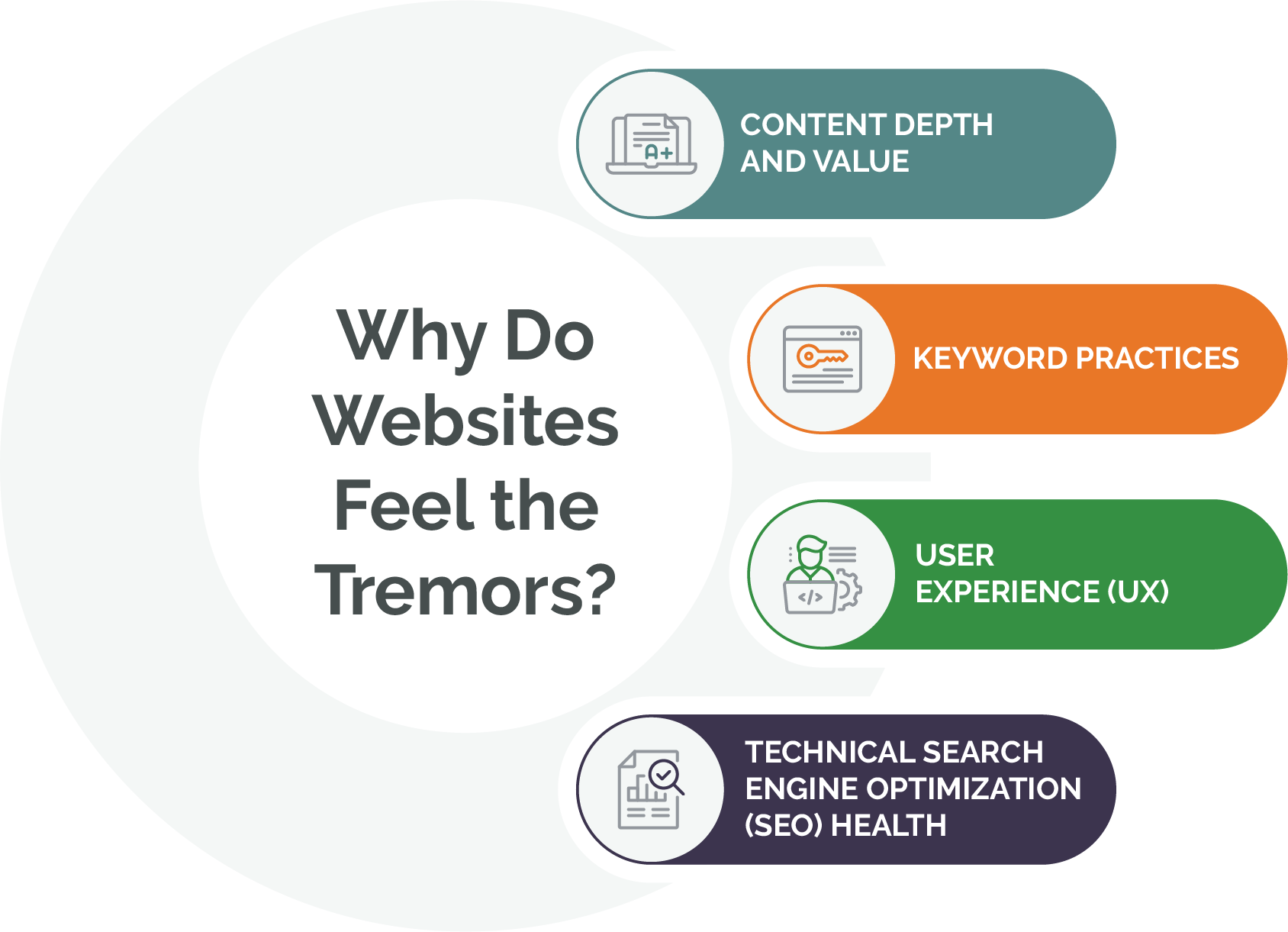If you’ve noticed sudden changes in your website's performance, you might be feeling the ripple effects of a Google algorithm update. These search engine updates can significantly shift your site's visibility on the web, and understanding whether you've been affected is crucial. But how can you stay on top of these (what feels like) constant changes? This blog will guide you through the signs of an algorithmic impact, uncover the reasons behind the changes, and offer actionable strategies to fix any ranking issues and prepare your website for the future.
Why Do Websites Feel the Tremors?
If you work in digital marketing, you know that when an algorithm change happens, it’s not to be taken lightly. When something shifts, it can dramatically affect your site's visibility and traffic. There are many reasons for a website to feel the impact of these algorithm changes, but they often come down to a few core issues:
- Content Depth and Value: Content that fails to offer real value or depth to the reader can quickly lose favor with Google. Search engines are refining their ability to discern quality, seeking valuable and informative content that satisfies user intent and queries.
- Keyword Practices: While keywords are one of the most essential elements of your website, overusing them can harm your site. Known as keyword stuffing, this over-optimization can trigger algorithmic penalties, as it detracts from the natural flow and usefulness of content.
- User Experience (UX): The digital world is unforgiving to websites that neglect the user's journey. Slow load times, mobile-unfriendliness, and cumbersome navigation are just like setting sail with a leaky boat – they're sure to be penalized by algorithms prioritizing a smooth, user-centric experience.
- Technical Search Engine Optimization (SEO) Health: The integrity of your website’s structure – from broken links to poor use of meta tags – can also impact how algorithms assess your site. Regular technical audits are essential to ensure your SEO foundations are solid.
Spotting the Signals of an Algorithmic Hit
As digital marketing strategies shift because of an algorithm update, how can you tell if your website has been affected? Here are a few tried and true signs that your website has been impacted and may need a swift response and course correction:
- Dip in Organic Traffic: A sudden and notable drop in organic traffic indicates possible trouble.
- Keyword Rankings Shift: Keywords that have lost their high-ranking positions or are subject to erratic movements could point to an algorithmic influence.
- SERP Changes: Changes in the search engine results page (SERP) layout or the appearance/disappearance of features such as featured snippets, local packs, or knowledge panels for your targeted keywords could indicate that an algorithm update has occurred.
- Comparative Performance: Examining your competitors' performance can offer clues. If they are not experiencing the same downturn, it could be specific to your website. However, if everyone is affected, it's likely an industry-wide algorithm change.
- Engagement Metrics: If you notice a drop in user engagement metrics like page session duration, pages per session, or an increase in bounce rate, it could be a signal that your content is no longer performing as well after an update.
Tracing the Footsteps of an Update
Now that you’ve noticed some of the signs above, it’s time to determine for sure if your website has been affected by a recent algorithm update: this involves several steps. First, you'll need to thoroughly examine your site's traffic data. Dive into your analytics and search for any substantial changes in your traffic volume that align with the dates of known algorithm updates. This can provide a preliminary indication of whether the update has influenced your site's visibility in search results.
Next, look into Google Search Console for potential insights. This free tool can offer invaluable information through its performance reports and notifications. Keep an eye out for any marked decrease in impressions or clicks and any significant drop in your average position that coincides with the timing of a Google update. These metrics can often reveal the direct impact of an algorithmic change on your site.
In addition to these tools, it's important to monitor SEO forums and news sources. The collective experiences and discussions within the SEO community can confirm the presence of an update and offer clues about its specific focus and effects. Participating in this dialogue can also provide early warning signs and help you respond more promptly.
Another critical step is to audit your backlink profile. Sudden changes in this area — such as losing high-value links or acquiring suspect ones — can negatively impact your site's authority and off-page rankings, especially after an update that targets link quality. If you notice these fluctuations around the time of an update, this could be a sign that your website has been impacted.
Lastly, scrutinize your content marketing strategy against current SEO best practices. Google's updates often aim to reward high-quality, relevant content and penalize sites that fall short. If your content quality or relevance is lacking, an algorithm update might exacerbate existing weaknesses, resulting in decreased rankings.
By methodically going through these steps, you can identify the areas that may require attention. This strategic approach allows for a more precise recovery plan, helping you to regain and enhance your site's search engine performance.
Crafting Your Comeback
Recovery Step One: Content Quality Check
Before diving into technical adjustments, it’s essential to ensure your content is up to par. High-quality content is the cornerstone of SEO, and your first step in recovery should be an exhaustive review of your site’s content.
- Audit Your Content: Scrutinize each page for outdated information, subpar writing, or content that lacks value. Enact the best practice by refurbishing low-quality content as needed.
Recovery Step Two: User Experience Enhancement
Your visitors' on-site experience has a significant impact on SEO. Prioritize making your site as accessible and user-friendly as possible to align with search engines' emphasis on user experience.
- Site Responsiveness: Guarantee a mobile-friendly interface.
- Navigation Ease: Streamline site structure for straightforward user journeys.
- Loading Speed: Use Google's PageSpeed Insights to identify and rectify performance bottlenecks.
Recovery Step Three: Backlink Profile Strengthening
Backlinks are the backbone of your website's authority. Conduct a thorough examination of your backlink profile to ensure it's helping, not hurting, your SEO efforts.
- Audit Backlinks: Disavow harmful links through Google Search Console.
- Build Quality Links: Aim for high-quality backlinks from authoritative and relevant domains.
Recovery Step Four: Ongoing SEO Health Monitoring
Consistent monitoring and adjustment of your SEO strategy are crucial in the ever-changing landscape of search algorithms. Keep a finger on the pulse of your website's analytics and search engine guidelines.
- Analytics Review: Keep track of traffic and ranking fluctuations.
- Guidelines Update: Stay informed on Google's Webmaster Guidelines.
- Strategy Adjustments: Adapt your SEO tactics in response to performance data and search engine updates.
By taking these proactive steps, you can help ready your website against future algorithm changes and maintain your visibility in search engine rankings.
Navigating the Aftermath: A Strategic Path to Recovery
After a Google algorithm update, regaining your website's place in search rankings can seem daunting. However, recovery is possible with a strategic approach centered on analysis, quality improvement, and adherence to SEO best practices. By embracing these challenges as opportunities for refinement, you can enhance your website's resilience against future updates and solidify its standing in the digital ecosystem.
Need help navigating these algorithm updates? Zero Gravity Marketing's digital experts can help sort through the complexities of SEO and algorithm updates. With the right approach and resources, you can turn the tide and transform a potential setback into a stepping stone for greater SEO success.
Google Algorithm FAQ:
How often does Google update its algorithm?
Google continually updates its algorithm to provide the best possible search results. Minor changes occur daily, but major updates, which can significantly affect search rankings, happen several times a year. Google reported making thousands of updates to their search algorithms each year, with some sources citing around 3,000 in recent years.
How does Google's search algorithm work?
Google's search algorithm uses a combination of algorithms and numerous ranking signals to deliver webpages ranked by relevance on its search engine results pages. When a user types a query into Google Search, the search engine examines its index and returns the results that are most relevant to the user's query. The algorithm looks at factors including the language of the query, relevance, and usability of pages, the expertise of sources, and your location and settings. The weight applied to each factor varies depending on the nature of the query.
What are core Google algorithm updates?
Core Google algorithm updates are significant changes that Google makes to its overall ranking algorithms. These updates are designed to improve users’ search experience by delivering more relevant, authoritative, and useful results. Unlike minor changes, core updates can have a noticeable impact on search results across all languages and can significantly affect website traffic and performance. Google typically announces these updates, which can take a few days to a few weeks to roll out fully.
How many Google algorithm updates are there per year?
Google makes thousands of changes to its algorithms every year. Most of these are minor tweaks that go unnoticed by the average user. However, there are usually several broad core algorithm updates every year that are more substantial. Webmasters and SEO professionals closely monitor these because they can affect search engine rankings and visibility. The exact number can vary, but Google has been known to make multiple notable updates within a single year.












